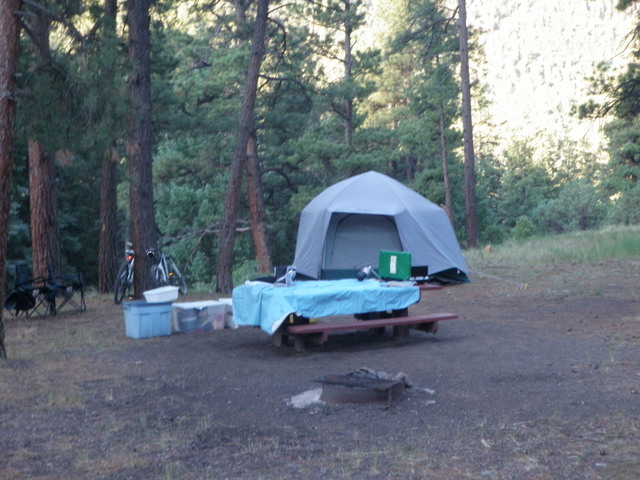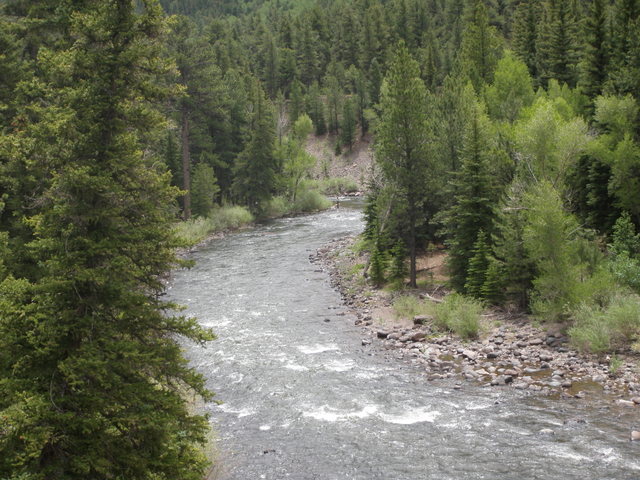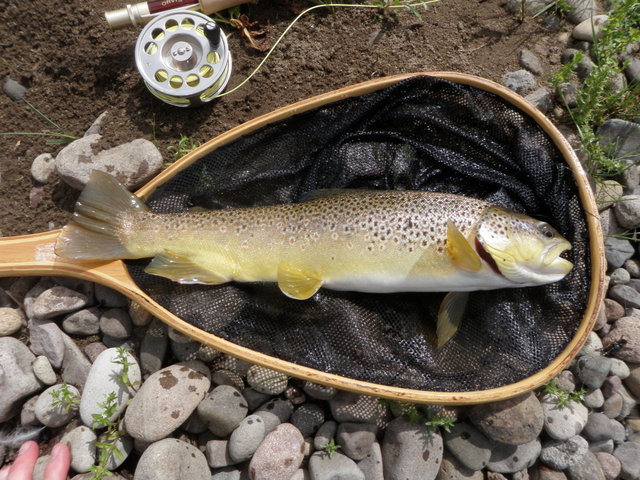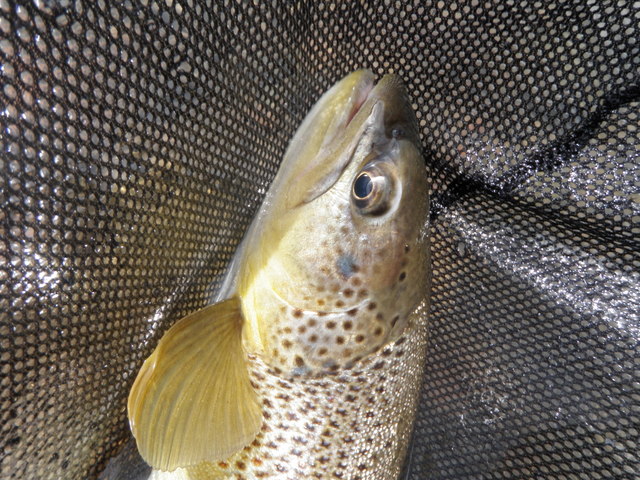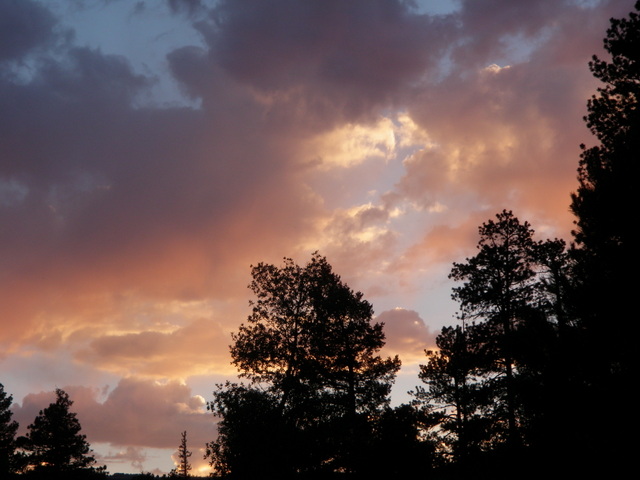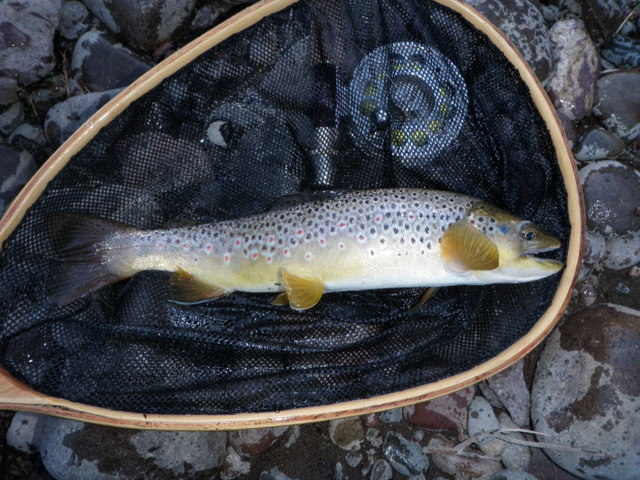Time: 9:00AM – 4:30PM; 7:00PM – 8:00PM
Location: 1.5 miles downstream from CO 105 bridge and then back up to bridge; nice pool next to the Lake Fork Campground
Conejos River 07/20/2016 Photo Album
I could not let the Conejos River beat me. I pondered my options for Wednesday on Tuesday night. I considered exploring the Conejos River above Platoro Reservoir, since it would be unaffected by water releases from the dam, but I was unfamiliar with this water and did not have a detailed map. Another option was to cut my losses and leave a day early and identify another decent fishing destination on Thursday or Friday closer to home. Of course the final alternative was to spend another day on the Conejos River. I chose the latter with a caveat. If the fishing was slow, I would quit at 2PM and return to the campsite and pack up and return to Denver.
Spending another day on the Conejos seemed like the correct choice for several reasons. First of all I drove nearly six hours to be there, so I really needed to give it another chance. My main motivation, however, was the observance of a few green drakes and a decent pale morning dun hatch on Monday around noon. Perhaps this was the leading edge of a more intense emergence, and it would be ashamed to abandon the Conejos just as it blossomed into prime productivity. July 20 was the start date of my two previous successful trips to the Conejos River.
On Wednesday morning I drove down CO 250 to the last place where the short grass and low bushes defined the landscape between the road and the river. Had I traveled farther, reaching the river necessitated battling through trees and dense shrubs. Once again I elected my Sage four weight, and after I slid into my waders and pulled on my packs, I hiked across the dry grass and angled down a bank to the river. I decided to experiment with some different approaches on Wednesday, and I kicked the day off by stripping a streamer. I clamped my reel containing a sinking tip line to the rod and knotted a slumpbuster to the short stiff tapered leader. My original plan envisioned working streamers for an hour, but after thirty minutes of fruitless manipulation of the small bait fish imitation with nary a follow, I made an adjustment. In fairness to the streamer advocates, the quality of the water at the outset of my day was not highly conducive to that methodology.
I removed the sinking tip line and restored the floating line that I stuffed in my backpack before departing from the car. I was now prepared to utilize a different method from the dry/dropper approach that I stubbornly embraced on Monday.
Wednesday was another sunny day in the morning, but dense clouds blocked the sun’s rays off and on during the afternoon. The flows seemed comparable to Monday, so my prayers for reductions from the water managers went unanswered. In fact, upon my return to Denver, I checked the graph, and flows remained consistently at 180cfs until they dropped to 130cfs on the day I departed. Typical. I reasoned that the fish were hugging the bottom as a result of the high flows and cold bottom releases, so I elected to utilize the strike indicator deep nymphing approach to fly fishing.
Keeping Them Wet
Between 9:30 and 11:30 I deployed a nymph approach, and the lineup featured a 20 incher and salvation nymph. The 20 incher was an attempt to imitate the nymph stage of a green drake, and the salvation nymph was the same for pale morning duns. In the first hour after switching to nymphs I landed two brown trout. The first landed fish was a very nice energized fourteen inch brown trout, and it snagged the 20 incher from the drift. The second twelve inch brown trout snatched the salvation nymph. So far so good. I was pleased that my adjustment delivered a pair of nice fish, and both my fly choices were recognized as prevalent food.
Nice Shelf Pool Yielded a Fish on a Green Drake Spinner
At 10:30 I approached a beautiful long deep shelf pool on the side of the river away from the road. Earlier I managed to cross the stiff flows at the wide shallow top of an island, and I remained on that side for the entire day. The left bank was simply more comfortable to fish by a right handed caster, and there were very few locations where I could risk another safe crossing. I surveyed the long attractive pool, and as I looked on, I spotted a flurry of rises. It was not obvious what was prompting the activity, so in between casts of the nymph set up, I focused on the water in front of me. On the third such inspection, I noticed a green drake spinner, and there was no mistaking the size and spent wings of the large western mayfly species.
Green Drake Spinner Eater
I impatiently removed the nymph paraphernalia, and tied on a cornuta spinner, as it was a similar shape and color. As I expected, it was ignored, as it was two sizes too small to copy the green drake that floated by. I searched my fly box once again, but there were no large spinners to pick from. What should I do? In the past I have had some success using a comparadun to imitate a spinner since it rides low in the film and has a fan shaped deer hair wing that protrudes from both sides of the body similar to a spinner wing. I dug out a size 14 green drake comparadun with no ribbing and applied floatant and smashed down the wing.
I was ready for another attempt at one of the earlier risers. I tossed the makeshift spinner above the spot were I observed a rise, and sure enough a nice thirteen inch brown materialized from the river bottom and confidently consumed my fly! Moments like this when a fly fisherman observes, reacts, adjusts and improvises are extremely gratifying. I lifted my rod and set the hook, and a brief battle ensued before I landed a chunky thirteen inch brown trout.
Coming off this success I quickly cast above one of the other risers, but this fish refused my comparadun, and then just as suddenly as the spinner fall commenced, it ended. The brevity of the spinner fall perhaps indicated that the density of green drake emergence in this area of the Conejos remained light. I was not eager to return to the deep nymph system, and I remembered that in July 2015 I prospected with a size 12 Harrop deer hair green drake with a salvation nymph dropper with a high degree of success. Why not try it again in this prime pool?
I found one of the Harrop drakes in my fly canister and attached it along with a salvation nymph. I cast across to a nice deep run along the roadside bank, and much to my amazement a weighty brown flashed to the surface and inhaled it. I played the fish for a bit, and then I was sorely disappointed when the drake slipped out of the mouth of my foe, and the trailing salvation foul hooked the brown trout in the body. Despite losing a nice fish, I was now excited that perhaps the Harrop drake and salvation nymph would reprise the 2015 success.
It did not. I continued prospecting the throwback combination and experienced a couple momentary hookups to the salvation, but then interest faded as I reached the top of the pool. I glanced at my watch and noticed it was 11:30, so I returned to the bottom to eat lunch early, as I expected a green drake and pale morning dun hatch to commence in thirty minutes.
Lunch Break
After lunch I saw no hatch, so I decided to revert to the deep nymphing approach. I was intrigued with the idea of working my the 20 incher and salvation through the deep shelf pool in case the trout were tuned into subsurface activity prior to a hatch. The strategy worked somewhat, as I landed a small brown on the 20 incher in the shelf pool, and then netted number five at the bottom lip of a short but deep narrow slot along the bank. This thirteen inch brown trout also inhaled the 20 incher. At one point during this deep nymphing phase I foul hooked a fish that stripped out fifty feet of line before it eventually came free without breaking off the flies. I breathed a sigh of relief as I escaped this near miss disaster, and I moved on and added a small brown to reach a fish count of six.
Yikes, Very Healthy
In the early afternoon as I waited for the mayfly hatch, my progress was rapid, because I skipped vast quantities of river real estate that were not conducive to fish holding away from the high velocity flows. In the midst of this period I encountered another juicy spot where two currents merged and created a deep trough. If ever there was deep nymphing water, this was it. I made five or six drifts with no response, but then on the next pass, the indicator dipped, and I was connected to a hot fish. The angry missile streaked to deep fast water, and within seconds it broke off both nymphs. The fish may have been foul hooked, but I will never know for certain.
I continued to anticipate green drakes and pale morning duns, but they were not cooperating. A type of aquatic insect that was appearing in greater quantities was stoneflies. I recognized small yellow Sallies, large golden stoneflies, and a version that was in between those two in size. I captured the medium version while eating lunch, and it approximated a size 14 stimulator with a light yellow body that exhibited tinges of green. I was not ready to abandon nymphing, but I filed this information in my brain for future reference.
Zoomed In Even More
When I replaced the broken off flies, I retained the salvation but exchanged the 20 incher for an iron sally. I resumed nymhing, but the temperature was peaking, and fish were not responding, and I was beginning to weigh the option of packing up and returning to Denver on Wednesday evening. It was at this low point that I approached a section characterized by wide shallow riffles. This water type was not conducive to deep nymphing, but was one of the few areas at high flows that screamed for a dry fly approach. My success level was non-existent, and I saw numerous large yellow Sallies, so why not try a size 14 light yellow stimulator? This fly was popular with the Elk Creek brown trout, so perhaps the main stem Conejos cousins loved them as well?
Yellow Stimulator Streak Begins
I had the foresight to restock my fly box with size 14 light yellow stimulators at the campsite, so I pinched one and knotted it to my line. I launched a long upstream cast, and as the visible fly danced through the riffles, a thirteen inch brown confidently slurped it in. My first thought was that I should have tried it earlier, but I was nonetheless elated with this dry fly success. Over the remainder of the afternoon I landed eight more brown trout by prospecting the small stimulator. Yes there were some refusals, but the move to the heavily hackled stimulator enabled me to salvage the day and find a consistent producer on the Conejos River in the absence of significant green drake and PMD activity. My decision to remain for one more day on the main river was vindicated.
Big Head with Stonefly Cases in the Background
The final eight fish included several in the thirteen to fourteen inch range, so the stimulator was not just a dink magnet. Of course I experienced some long distance releases as well, and several of these were substantial fish. I covered 1.5 miles of river, as the trick was to skip around vast sections of pure rapids and focus only on spots that were obvious fish holding lairs. The best places to cast a fly were relatively shallow riffles of moderate velocity and deep slower moving bank side pockets. One particularly productive wide shallow riffle yielded three twelve inch browns, and a memorable series of narrow pockets along the bank produced two very nice browns. A third brown at the top of this area swirled and refused the stimulator, but this visual elevated my heart rate for a brief moment, as it was probably the best of the three fish.
Pretty Section of the Conejos
I fished for seven hours and covered significant stream miles, so the Conejos made me earn my success. If I landed a higher percentage of my hook ups, I could have easily attained a fish count of twenty. The river was reluctant to reveal its fish, and the fish were reluctant to find my net. In my opinion Conejos River brown trout are pound for pound some of the hardest fighters, that I encountered in my many years of fly fishing. Landing fifteen healthy battling Conejos River brown trout in high flows without the benefit of a green drake or pale morning dun hatch was a significant achievement.
After dinner at the campground on Wednesday evening I strolled down the road to the river and checked out the nice hole behind my campsite in 2015. As I looked on, some fish rose, so I quickly returned to site number six to collect my gear and prepared to fish. A cluster of spinners bobbed over the dirt road in the campground, so I should have recognized this as a sign of what was ahead.
Home of Elusive 16″ Brown
The wide pool was situated behind a large exposed midstream boulder with strong deep currents forming the outside border on both sides. One of those strong currents was between my position and the pool, and this made countering drag quite challenging. Initially I prospected a size 14 gray caddis in the bottom half of the pool since the rising fish were in pause mode. The fish did not respond to the caddis, so I paused to observe and noticed a large mass of bobbing spinners above the pool. After a brief period, the rises resumed, although they were in the upper half of the pool this time. I concluded that some of the mating spinners hit the water, so I opened my fly box and spotted a size 16 rusty spinner and tied it to my line.
As I mentioned, it was extremely difficult to obtain a drag free drift as the strong current in front of me grabbed the fly line instantly. Also several tall trees were behind me, and this forced me to be very cautious of my backcasts. I managed to elicit two refusals to the rusty spinner, and it was not clear if the rejection stemmed from a poorly matched fly or drag. Eventually I would discover that it was probably the former.
Periodically the cloud of spinners vanished, and in each case the rises disappeared. Clearly there was a relationship between spinners and feeding fish. During one of the lulls a sixteen inch brown trout launched two feet above the water near the top of the pool in the area where the merging currents made it nearly impossible to create a drag free presentation. I could only observe the spinners from a distance, but they seemed to exhibit pink or light maroon bodies from a distance. Unfortunately none of these were present in my fly box. But wait a minute, what about the comparadun ruse that performed earlier on Wednesday for the green drake spinner?
Size 16 Cinnamon Comparadun with Mashed Down Wing Served As Effective Spinner Substitute
I quickly found a size 16 cinnamon comparadun and tied it to my line after mashing down the wing. Success! Two browns slurped the comparadun with the best measuring twelve inches. And what about the large brown in the heart of the swirling currents? The big boy was very discrete and cautious in its rises. As I cast to other risers, I continued to revisit the beast, and finally my heart leaped when a big head emerged and engulfed my mashed wing comparadun. As soon as my hook set pierced its lip, the brown leaped out of the water in the same manner as I witnessed earlier. Since I saw the beast twice, I knew I could not force it to my net, so I allowed it to spin line from my reel, and it charged to the far side of the large boulder at the top center of the pool. I anticipated this as trouble, so I pressured it a bit and felt pulsing thus confirming that I was still attached. The brown seemed to be sulking under the rock, so I stripped a bit of line to coax it away from the structure, but in the next instant my line went limp and the comparadun was missing in action. What an ending to a challenging yet successful day on the Conejos River.
Campground Pool Brown
Fish Landed: 17

